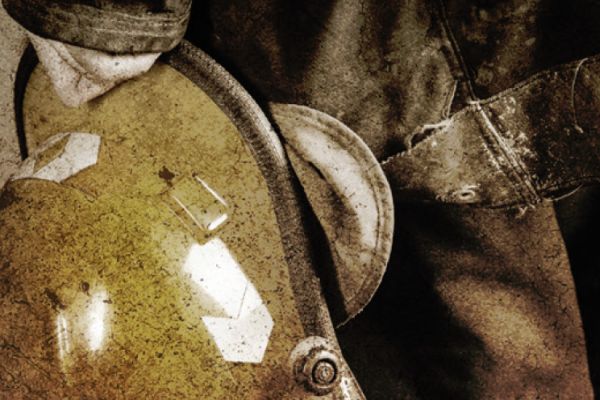If you’ve visited an NHS hospital recently, you’ll know that the squeeze on resources can be felt even while parking the car. Arriving at the Royal United Hospitals Bath before visiting hours, I’m relieved to find a space and make my way towards the staff counselling service. Situated in one of the hospital’s older buildings, it’s discreetly positioned away from the busyness of the main hospital entrance.
I’m here to meet Cindi Bedor, who leads the counselling service, for coffee and to talk to members of her team before the first clients of the day arrive. If, like me, you’ve worked in some rather drab and neglected public sector buildings, you’ll understand why entering through the doors of this counselling service felt like a far cry from my usual experience. I’m soothed by the calm, the soft light, the plants and colour palette. Art on the walls, classical music for the soul and a carefully considered choice of self-help literature. It’s understated, professional and therapeutic.
‘One of the most consistent pieces of feedback we have is about the quality of the waiting room and how staff feel when they arrive here,’ Cindi explains. I’m not surprised. It’s carefully tended to and designed to give stretched NHS staff something that is in short supply in their working lives: a feeling of quiet. ‘Hospital staff experience overload in every way, including sensory demands, so we try to avoid further overloading them with too many leaflets, unkempt therapy rooms, waste bins full of tissues, or even a radio station with commercials that intrude into the waiting room.’
The sound of sirens is a reminder that this in-house counselling service is actually part of an acute hospital. Established in 1987 and only the second of its kind in an NHS hospital, the service is now well embedded in the organisation. The reality of the day-to-day life of health professionals in the NHS is never far away, I’m told, and winter always brings a greater strain on the NHS. ‘The pressure within the hospital always comes into the counselling room’, explain Alison Lock and Sophie Pickering, two members of the counselling team. ‘High escalation levels occur when there is unrelenting pressure on beds and everyone is working flat out. There’s a different energy in the hospital and we can just feel it.’
Working flexibly
Responding to this pressure, Cindi explains how the service holds the context of its clients’ work in how it contracts. ‘Our flexibility with missed or cancelled appointments allows us to remain engaged with our clients, and we try to balance this with a consistent approach, through our warmth and approachability, our systems and procedures and our boundaries. We are sensitive to the nature of the work, the shifts, and the huge pressures on staff. Being on site means that we have a strong sense of the demands healthcare workers face and we are easy for them to access when they can.’
There’s pride in how Alison and Sophie speak about their work, their team and its integral role within the hospital. ‘We are an informal presence and we’re accessible to those who need us, regardless of their role in the hospital. People see us as being available and that we’re here for them.’ They are clear that Cindi’s style of leadership is pivotal to the reputation of the service and to how highly regarded it is across the hospital. ‘Cindi’s work focuses so much on building relationships and working with teams and managers. Much of our work is hidden, but our presence is felt as a safe place.’
Understanding the culture
Organisations are notoriously difficult places, and the distinct cultures of therapy, medicine and business are not natural bed fellows. It means that whoever leads the service, must be able to communicate the value of therapy to the organisation and to understand how therapists can offer it. ‘The proof for me of our value in the organisation is when staff contact us,’ says Cindi. ‘They are busy, they don’t like to concede what they perceive as weakness, they often don’t know themselves what they want, but they do know they are struggling, and I feel privileged each time a manager or clinical specialist contacts me. Our service has been invited to work with some of the most senior teams in this hospital, including the consultants, to provide reflective supervision for the whole team. This shows an enormous display of trust, which has grown out of staff feeling psychologically safe enough to work with us.’
Alongside leading the service, Cindi’s clinical work keeps her connected to her own passion for and belief in therapy: ‘I’ve seen extraordinary therapy happen: it’s short term, often appointments have to be fitted around shifts or hospital pressures, and sometimes we have to be very creative in the way we keep our clients engaged. But, I have come to truly believe in the power of therapy with and within organisations, and it is good to see a growing movement of compassion in healthcare, which we are very much a part of.’ This culture shift has come as a result of the Francis Inquiry into abuse at the Mid Staffordshire Foundation Trust Hospital and following Paul Gilbert’s work on the compassionate self. It’s a shift that Cindi has built on, keeping a focus on how the service can continue to support staff to deliver their best under enduring pressure; and how to share what we’ve learnt as therapists from attachment theory and neuroscience about how humans function.
Connecting and reconnecting
Healthcare professionals, by the very nature of their work, are trained to put the needs of others above themselves. They tend to have a strong sense of vocation, duty and passion to give the best possible care to their patients, and for them to go the extra mile to achieve this is not unusual, explains Cindi. But it’s a vocation that comes with inevitable risks: ‘Much of our work is about connecting and reconnecting. It’s important for all of us to have a passion for our work, and so often we are helping NHS staff to reconnect with what’s brought them into their work, because they can lose this when they become tired, exhausted and burnt out.’
There are potentially five thousand clients working in the hospital and the service sees between ten and eleven per cent of the workforce for one-to-one work. Clients are provided with up to four sessions and careful attention is given to endings, Cindi tells me. ‘When we end with our clients, it’s standard practice as part of our package to write to each and every person to acknowledge the work has ended and to remind them that they can use the service again. Clients are also offered a follow-up session, and we have a twenty per cent take-up rate for those. With some of our clients, especially those we know are facing enormous pressures, we email them a few weeks later to see how they are. Sometimes my emails are strategically written to arrive in the recipient’s inbox when I know there’s a maximum chance they will see it.’
In addition, the service provides relationship counselling for couples, coaching, specialist addiction and PTSD therapy, workplace mediation and clinical supervision. Working upstream with hospital staff, trainings are delivered by members of the service and include training managers about mental health, working with anxiety at work, and self-care and resilience for staff across the workforce. Cindi tells me that the service also gained funding to provide eight-week mindfulness training to all staff, which it has done for the past two years, as well as running courses specifically for doctors, and it will begin mindfulness training for leaders in the spring.
Making the business case
The culture shift that’s occurring in the nation’s psyche around mental health means that there’s a growing understanding of what Cindi’s service is providing. ‘When I completed my training over twenty years ago, counselling wasn’t in the mainstream as it is now,’ she tells me. ‘I joined an in-house team of counsellors, and we always had to defend our work and justify our presence in the organisation and to argue the business case. This has continued throughout my career and while I’ve been running this service. Anyone who’s ever managed a service will know what I mean when I talk about the amount of energy and work that goes into fighting for our continued existence.’
But there was a turning point some years ago which has had profound consequences for Cindi’s leadership: ‘I realised that I didn’t have to keep fighting and selling the service. I never received an explicit statement to say our service is safe, and I still don’t take that for granted. But I realised that I didn’t need to sell the value of the service anymore. We were being integrated more and more into the organisation, and at all levels there was interest in the information, insights and advice we could offer. That said, we can only do what we do because the Trust has shown its continued commitment to offering our service to their staff.’
Service managers often talk of needing to have the evidence for the efficacy of an in-house service readily available for stakeholders, and I’m wondering how important this remains as the service marks its twentieth year. ‘I still have the evidence base and I believe outcomes are very important,’ Cindi says, ‘but I am now much more confident about defining the outcomes I believe are important, rather than acquiescing to what other people (who are not in the fields of psychology) think are good outcomes but are either not realistic or meaningful.’
Engaging a team
Leading a service also means being responsible for recruiting and engaging therapists, whose livelihoods depend on your capacity to defend your service. Does Cindi recognise these layers of responsibility that rest with her? ‘It does feel quite a responsibility. We have an amazing team of therapists who are very committed to the service, and it is important to me to create a strong sense of teamwork and to support their ongoing development as workplace counsellors. I also believe that service leaders have much to contribute to our profession. Through our work in organisations, we potentially reach thousands of clients and we have the opportunity to model what therapy stands for and to spread the word of its potential.’
It’s no surprise that this is a place where therapists want to work and where retention is good. Alison and Sophie explain: ‘We have a low turnover of counsellors because we’re very well supported and we work well together. We network and gather twice a year for CPD, for socialising and lunch. We’re not micro-managed and we are trusted and respected for our different ways of working,’ they both tell me. Appointments take place onsite, which means the team create the environment, manage appointments and maintain sound clinical governance. Cindi describes the therapists who work in the service as all being good team players: ‘We enjoy learning from each other’s practice and having a consistent source of personal and professional support.’
Often, service leaders tell me that they are inundated by applicants when posts are advertised but can narrow down a shortlist quickly, because too few therapists understand what it means to work in an organisational context. I wonder if this is Cindi’s experience? ‘I’m looking for therapists who’ve done their own therapeutic work and who really understand their own transference around authority and power. We need practitioners with maturity, and that’s not the same as not being young. I have just engaged our first trainee in our service, who is very mature with lots of life experience. But on the whole, we’re a mature team and we welcome some new blood to challenge our thinking. Interestingly, the trainee approached me and said, ‘everyone told me to come and speak to you.’ I take it as a compliment. I think that’s a role that I, or we as service managers, can take more seriously: how do we mentor a new generation of workplace counsellors?’
Looking ahead, Cindi sees workplace counselling as a growing area that is deserving of more discussion, understanding and promotion by BACP and in society. ‘The therapy that this service does is touching a lot of ordinary people’s lives who would never access therapy privately, and surely there are enormous possibilities for our profession to expand this work.’
Working creatively
Therapy is a term that Cindi uses in its broadest sense and it goes beyond the conventions of two people in a room. It often happens during her corridor conversations, while walking the hospital, coming across staff and making connections. She tells me how one day she bumped into the hospital’s Arts Officer, and between them they developed ‘the sleep project’. Tapping into an internal innovation fund, together they developed a plan to make 100 sleep packs for shift workers to encourage them to go home and get some proper sleep. This gem of an idea pooled the creativity of staff right across the hospital, who were all invited to volunteer their needlework skills, and to reuse unwanted fabrics.
Staff came up with their own unique design for small bags, (much like the inflight bags you have on long-haul flights, only nicer, and each one individually designed), in a range of recognisable fabrics, including: a man’s pyjamas; a winceyette nightie; and an old pair of scrubs. The hundred sleep packs were then handed out to the matrons to distribute to sleep-deprived shift workers to encourage self-care, rest and sleep. Each sleep pack contained an eye mask, earplugs, a lavender sachet, one herbal sleep teabag and an information leaflet on sleep. The response Cindi received from the matrons speaks volumes: ‘What surprised me was how much this gesture meant to them, to be given something that they in turn could give to their staff, when so often they are struggling with such a scarcity of resources.’
Closing thoughts
The clock ticks, and it’s time for the team to begin to prepare for the first client to arrive. As we pick up our coffee cups and straighten the room, Cindi tells me: ‘We have rituals for how we begin and end with the room. We make the space; it doesn’t make itself.’ The sense of collective responsibility in this service, is clear. So too is my overwhelming sense that this is what leading by example looks like.
There is nothing ordinary about this counselling service. It is embedded into the working life of the hospital and is led by a practitioner who knows how to take the best from therapy and make it make sense to people right across her organisation. I’ve edited this journal for five years and witnessed internal services being dismantled and outsourced, resulting in colleagues losing their livelihoods, and organisations losing years of therapeutic expertise, knowledge and good working relationships. There is much that our profession needs to learn from the success story of this in-house service supporting NHS staff; it is part of one of the nation’s most important institutions, and as it marks its twentieth anniversary, it is thriving.
Nicola Banning is a BACP accredited counsellor specialising in working with individuals and organisations, and is editor of this journal. She has a background in broadcasting with the BBC and writes on counselling, mental health at work and professional development.
More from Counselling at Work

Talking feelings with firefighters
Open article: How do you improve mental health in the fire service? Lisa Jenner reports on an initiative by Gloucestershire Fire and Rescue Service to tackle mental health stigma through education and support. Counselling at Work, Autumn 2017

Cancer in the room
Open article: Caroline Feldon Parsons reflects on her work with clients with cancer. Counselling at Work, Summer 2017

The training gap
Open article: Employee support is a growth area in the therapy world, but the opportunities for trainees to find placements are scarce. Nicola Banning finds out how one pioneering EAP is responding to bridge the gap. Counselling at Work, Spring 2017
